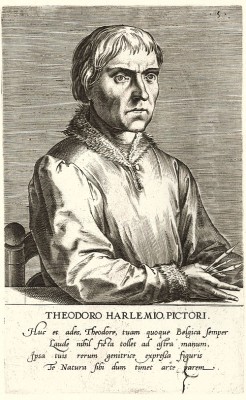
Dieric Bouts, a name that resonates with the quiet intensity and profound piety of the Early Netherlandish Renaissance, stands as a significant artistic figure of the 15th century. Active primarily in Leuven, Bouts carved a unique niche for himself, blending the meticulous realism pioneered by his predecessors with a distinctive, somewhat austere, yet deeply human sensibility. His contributions to religious painting, portraiture, and the nascent development of landscape art mark him as an innovator whose influence extended beyond his own lifetime, touching the work of his sons and later generations of artists in the Low Countries.
Early Life and Formative Influences
The precise details of Dieric Bouts's early life remain somewhat shrouded in the mists of time, a common challenge when studying artists of this period. He is believed to have been born in Haarlem, in the northern Netherlands, around 1415. This origin would place him in a region already stirring with artistic innovation, though distinct from the burgeoning artistic centers of Flanders like Bruges and Ghent. The artistic environment of Haarlem at this time included painters like Albert van Ouwater, who is also considered one of the earliest figures in North Netherlandish oil painting, and whose work Bouts may have encountered.
It is widely accepted by art historians that Bouts received significant training, possibly in Brussels, under the tutelage of the great Rogier van der Weyden. Van der Weyden, who succeeded Jan van Eyck as the most influential painter in the Burgundian Netherlands, was renowned for his emotionally charged religious scenes, elegant figural compositions, and profound psychological insight. The impact of Van der Weyden's style is palpable in Bouts's work, particularly in the elongated figures, the careful articulation of emotion (albeit more restrained in Bouts), and certain compositional strategies. However, Bouts was no mere imitator; he absorbed these influences and forged a distinct artistic identity. The influence of Jan van Eyck, with his unparalleled mastery of oil paint, luminous detail, and complex iconography, also permeates Bouts's approach to realism and texture.
A Career Forged in Leuven
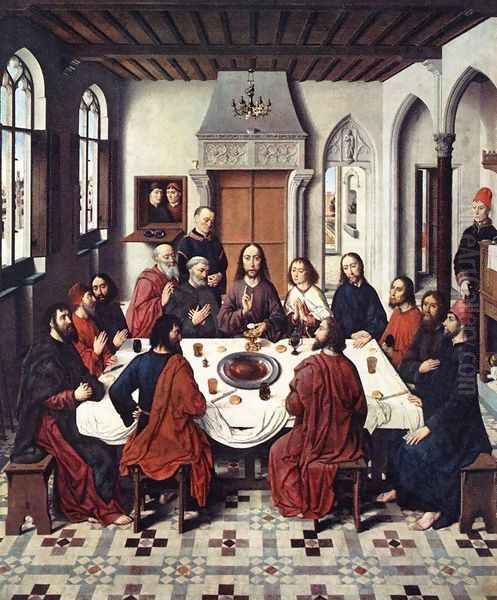
Around 1448, Dieric Bouts relocated to Leuven, a thriving university city in the Duchy of Brabant (now in Belgium). This move marked a pivotal point in his career. Leuven provided a sophisticated and intellectually stimulating environment, with patrons from the university, the church, and the prosperous citizenry. Bouts established himself as a leading painter in the city, and his presence is first officially documented in Leuven archives in 1457.
He married Katharina van der Bruggen, who came from a wealthy Leuven family, further solidifying his social and economic standing. They had four children, two of whom, Dieric Bouts the Younger and Aelbrecht (or Albert) Bouts, would follow in their father's footsteps and become painters themselves, continuing his workshop and artistic style, albeit with their own variations.
Bouts's reputation grew steadily, and he received numerous important commissions. His status was officially recognized when, from 1468 until his death, he served as the official painter of the city of Leuven. This prestigious position would have involved creating works for civic buildings and fulfilling other official artistic duties, underscoring his esteemed position within the community. He operated a successful workshop, which would have employed assistants and apprentices to help manage the workload of large-scale commissions. Dieric Bouts passed away in Leuven on May 6, 1475, leaving behind a significant body of work and a lasting artistic legacy.
The Boutsian Style: Precision, Piety, and Perspective
Dieric Bouts's artistic style is characterized by a unique blend of meticulous realism, restrained emotionality, and an innovative approach to spatial composition. While he learned much from masters like Rogier van der Weyden and Jan van Eyck, his work possesses a distinct character that sets him apart.
Realism and Detail: Like his Early Netherlandish contemporaries, Bouts demonstrated an extraordinary capacity for rendering the tangible world with precision. Textures of fabrics, the gleam of metal, the translucency of glass, and the nuances of human flesh are all depicted with painstaking care. This commitment to realism extended to the settings of his religious scenes, which often incorporated contemporary architecture and furnishings, making the sacred narratives more immediate and relatable to his 15th-century audience.

Emotional Restraint: Compared to the often-dramatic pathos found in the works of Rogier van der Weyden, Bouts's figures typically exhibit a more subdued and introspective emotional state. Their piety is conveyed through solemn expressions, dignified gestures, and a sense of quiet contemplation. This has led some scholars to describe him as a "painter of silence." His figures are often slender, somewhat elongated, and possess a certain stillness, even in moments of narrative action. This restraint does not imply a lack of feeling, but rather an internalization of spiritual experience.
Innovation in Perspective: Dieric Bouts is recognized as one of the first Northern European painters to systematically employ linear perspective, particularly a single vanishing point, to create a convincing illusion of depth in his compositions. While Italian artists like Filippo Brunelleschi, Leon Battista Alberti, Masaccio, and Paolo Uccello were concurrently developing and codifying the principles of scientific perspective in Florence, Bouts's application in the North appears to have been a somewhat independent or parallel development. This is most famously demonstrated in his Last Supper panel.
Color and Light: Bouts utilized a rich and harmonious palette, often employing deep, resonant colors. His handling of light is subtle yet effective, modeling forms and creating atmosphere. He was a master of the oil glazing technique, building up layers of translucent paint to achieve luminosity and depth of color, a hallmark of Early Netherlandish painting perfected by Jan van Eyck.
Landscape Painting: Bouts made significant contributions to the development of landscape painting. While landscapes in earlier works often served as schematic backdrops, Bouts began to treat them with greater naturalism and as integral parts of the composition. His landscapes are characterized by their depth, atmospheric quality, and careful observation of natural details, prefiguring the more specialized landscape painting that would flourish later in Netherlandish art with artists like Joachim Patinir.
Masterpieces of Devotion and Justice
Dieric Bouts produced a significant body of work, primarily religious altarpieces and portraits. Several of his masterpieces stand out for their artistic innovation, devotional power, and historical significance.
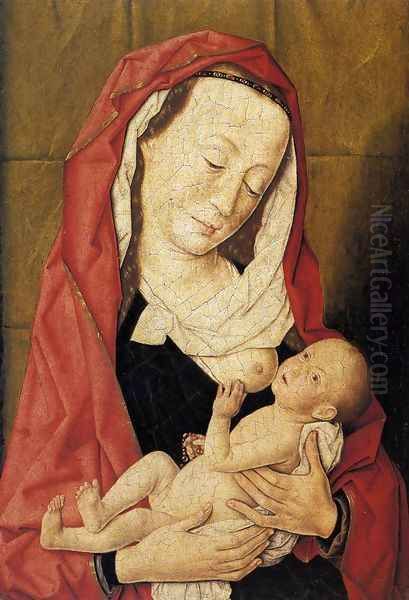
The Last Supper (Central Panel of the Altarpiece of the Holy Sacrament): Commissioned by the Confraternity of the Holy Sacrament in Leuven for St. Peter's Church, and completed between 1464 and 1468, this is arguably Bouts's most famous work. The central panel, depicting the Last Supper, is a landmark in the history of art for its sophisticated use of single-point perspective. The orthogonal lines of the floor tiles, ceiling beams, and side walls converge towards a vanishing point located above Christ's head, creating a remarkably coherent and deep interior space. Christ is depicted at the moment of the institution of the Eucharist. The apostles are arranged around the table with a solemn, contemplative air, their individual reactions subtly conveyed. The room itself is a contemporary 15th-century interior, complete with Gothic windows offering glimpses of an outdoor scene. Four figures in contemporary dress, likely members of the confraternity or portraits of the artist and his sons, observe the scene from the periphery, further blurring the lines between the sacred past and the viewer's present. The side panels of the altarpiece depict Old Testament prefigurations of the Eucharist: Abraham and Melchizedek, The Gathering of the Manna, Elijah in the Desert, and The Feast of the Passover.
The Martyrdom of Saint Erasmus Triptych: Also housed in St. Peter's Church, Leuven, this triptych, created earlier in Bouts's career (c. 1458-1464), depicts the gruesome martyrdom of Saint Erasmus, who is shown being disemboweled. Despite the horrific subject matter, Bouts maintains a characteristic sense of composure and order. The saint endures his suffering with stoic resignation, while the executioners carry out their task with a detached efficiency. The flanking panels show Saint Jerome and Saint Bernard. The work is notable for its rich colors and detailed rendering of figures and landscape.
The Justice of Emperor Otto III Diptych: Painted between 1470 and 1475 for the Leuven Town Hall, this diptych illustrates a story of justice from the 10th century. The left panel, The Execution of the Innocent Count, shows the beheading of a count falsely accused of adultery by the empress. The right panel, The Ordeal by Fire, depicts the count's widow proving her husband's innocence by undergoing the ordeal of holding a red-hot iron bar without being burned, leading to the empress's own execution. This work, intended for a civic setting, served as an exemplum virtutis, a reminder of the importance of justice. Bouts renders the narrative with clarity and a focus on the solemnity of the events. The figures are dignified, and the compositions are carefully balanced. This work was left unfinished at Bouts's death and may have been completed by other hands, possibly including Hugo van der Goes, though this is debated.
Virgin and Child Compositions: Bouts produced numerous depictions of the Virgin and Child, which were popular for private devotion. An exquisite example from around 1455-1460 is now in the National Gallery, London. These works typically show the Virgin tenderly holding the Christ Child, often within an intimate domestic interior or against a landscape backdrop seen through a window. Bouts excels in conveying the gentle, loving relationship between mother and son, characterized by his typical quietude and refined execution. The delicate modeling of the faces and the soft textures of the drapery are hallmarks of his style in these intimate pieces.
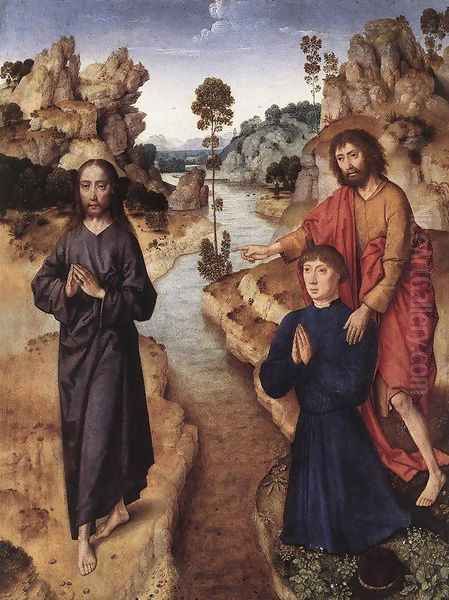
Ecce Agnus Dei (or St. John the Baptist Pointing to Christ): This work, dating to around 1462-1464 and housed in the Alte Pinakothek, Munich, shows St. John the Baptist in a lush landscape, pointing towards Christ who appears in the distance. The detailed rendering of the foliage and the atmospheric perspective in the landscape are particularly noteworthy, showcasing Bouts's skill in this area.
The Workshop and Artistic Legacy: The Bouts Dynasty
Like many successful artists of his time, Dieric Bouts maintained an active workshop in Leuven. This workshop would have assisted in the preparation of panels, the grinding of pigments, and the execution of less critical parts of paintings, and perhaps even entire replicas or variants of successful compositions. The existence of a workshop helps explain the volume of work attributed to Bouts and his circle.
His artistic legacy was most directly continued by his two painter sons, Dieric Bouts the Younger (c. 1448–1491) and Aelbrecht Bouts (c. 1451/60–1549). Dieric the Younger seems to have inherited his father's workshop and continued to work in a style very close to his father's, so much so that attributions can sometimes be difficult. Aelbrecht Bouts had a longer and more prolific career, developing a more distinctive personal style characterized by more intense colors and sometimes more expressive, even slightly cruder, figures. He specialized in devotional images, particularly depictions of Christ as the Man of Sorrows and Salvator Mundi, which were widely popular.
The influence of Dieric Bouts the Elder extended beyond his immediate family. His innovations in perspective and landscape, his meticulous technique, and his solemn figural types resonated with other artists in Leuven and beyond. While perhaps not as widely influential internationally as Jan van Eyck or Rogier van der Weyden, his impact on the development of painting in the Northern Netherlands and the Duchy of Brabant was significant. Later painters of the Dutch Golden Age, though centuries removed, inherited a tradition of realism and detailed observation that had its roots in the work of pioneers like Bouts.
Contemporaries and Artistic Milieu
Dieric Bouts operated within a rich and dynamic artistic environment. The 15th century was a period of extraordinary artistic flourishing in the Burgundian Netherlands. Besides his presumed teacher Rogier van der Weyden and the foundational Jan van Eyck, other key figures shaped this era.
Petrus Christus (c. 1410/1420–1475/1476), active in Bruges, was a contemporary whose work also shows an interest in rational spatial construction and refined portraiture. Some scholars suggest a mutual influence or shared interest in geometric perspective between Bouts and Christus.
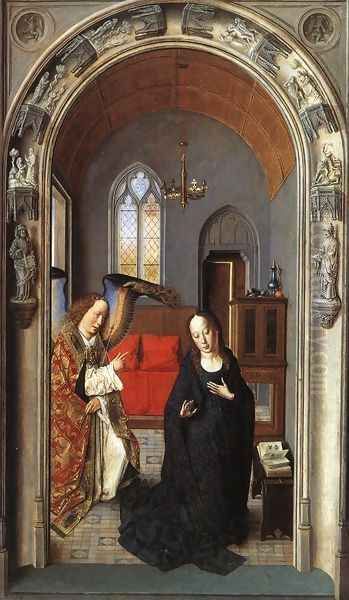
Hans Memling (c. 1430–1494), though slightly younger and active primarily in Bruges after Rogier van der Weyden's death, developed a serene and elegant style that became immensely popular. His work, like Bouts's, often features calm, pious figures and beautifully rendered details, though Memling's figures tend to possess a softer, more idealized beauty.
Hugo van der Goes (c. 1430/1440–1482), active in Ghent and later near Brussels, was another major contemporary. His art is characterized by a greater psychological intensity and emotional drama than Bouts's, as seen in his monumental Portinari Altarpiece. As mentioned, there is speculation that Van der Goes may have had some involvement in completing Bouts's Justice of Emperor Otto III diptych after Bouts's death.
In the Northern Netherlands, artists like Geertgen tot Sint Jans (c. 1460/1465–c. 1490/1495), active in Haarlem later in the century, continued to develop a distinct regional style, known for its gentle emotionality and innovative handling of light, particularly in night scenes.
The broader European context also included significant developments in Italy, where artists like Andrea Mantegna, Piero della Francesca, and Giovanni Bellini were pushing the boundaries of perspective, anatomy, and classical form. While direct connections are harder to trace, the general Renaissance spirit of inquiry and naturalism was a Europe-wide phenomenon. French artists like Jean Fouquet and Enguerrand Quarton were also producing significant works that shared some of the Netherlandish concern for realism and devotional intensity. Even artists from the Germanic regions, such as Konrad Witz or Michael Pacher, were part of this broader Northern European artistic transformation.
Unraveling Bouts: Anecdotes, Mysteries, and Scholarly Inquiry
Despite his significance, aspects of Dieric Bouts's life and work remain subjects of scholarly discussion and intrigue.
The Birthplace Question: While Haarlem is generally accepted as his birthplace, definitive proof is lacking, and some older sources suggested Leuven. The Haarlem connection is supported by stylistic links to early North Netherlandish art.
Attribution Challenges: As with many artists of this period who ran workshops, definitively attributing every work solely to the master's hand can be challenging. The close stylistic similarities between Dieric Bouts the Elder and Dieric Bouts the Younger have historically led to confusion. For instance, The Last Supper altarpiece was, for a time in the 19th century, mistakenly attributed to Dieric the Younger. Modern technical analysis, including X-ray radiography and infrared reflectography, has been invaluable in clarifying attributions and understanding workshop practices, revealing underdrawings and compositional changes.
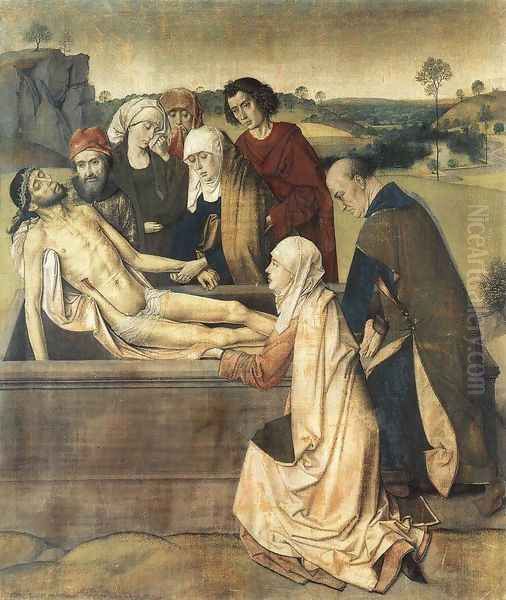
The "Painter of Silence": This moniker, while apt in describing the restrained emotionality of his figures, is a modern interpretation. Understanding how Bouts's contemporaries perceived this aspect of his style is more difficult. Did they see it as a mark of profound piety, a deliberate artistic choice, or simply his characteristic manner?
Influence of Mysticism: Some scholars have explored potential connections between Bouts's art and contemporary religious movements, such as the Devotio Moderna, which emphasized personal piety and inner spiritual life. The introspective quality of his figures might reflect these spiritual currents. The writings of Thomas à Kempis, particularly The Imitation of Christ, which originated from this movement, promoted a similar focus on quiet contemplation and devotion, which seems to resonate with the mood of Bouts's paintings.
Preservation and Dispersal: Like many large altarpieces, some of Bouts's works have been dismantled over the centuries, with panels dispersed to different collections. Reconstructing their original configurations and understanding their original liturgical or civic contexts is an ongoing task for art historians. The Last Supper altarpiece, for example, had its wings sold off in the 19th century and were later repurchased and reunited with the central panel, though not before spending time in museums in Berlin and Munich.
Art Historical Reception: Acclaim and Critical Perspectives
In his own time and in the decades following his death, Dieric Bouts was clearly a highly respected and successful artist, particularly in Leuven. His appointment as city painter and the significant commissions he received attest to this. His sons continued his workshop, indicating a sustained demand for his style of painting.
However, with the shifting artistic tastes of the later Renaissance and Baroque periods, Early Netherlandish painters, in general, fell somewhat out of fashion, though their technical brilliance was often still admired. The 19th century saw a renewed scholarly and public interest in these "Flemish Primitives," as they were then often called. Figures like Bouts were rediscovered and their contributions re-evaluated.
Modern art historical assessment generally places Bouts as a key figure in the second generation of Early Netherlandish masters. He is praised for his technical skill, his innovative use of perspective, his contributions to landscape, and the unique, quiet dignity of his figures. His Last Supper is universally recognized as a masterpiece of composition and devotional art.
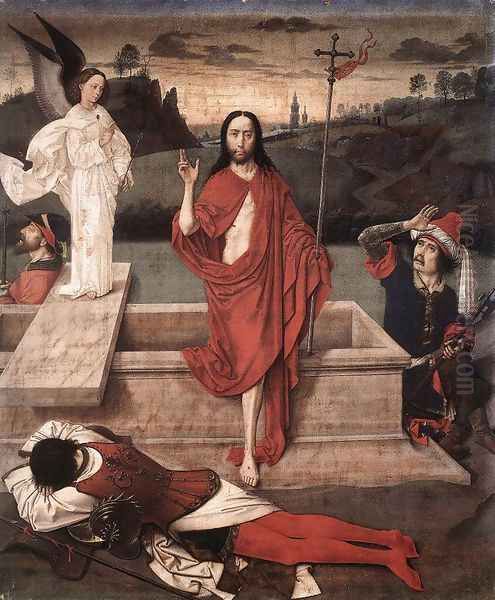
However, some critical perspectives have also emerged. Compared to the dramatic intensity of Rogier van der Weyden or the profound intellectual depth and symbolism of Jan van Eyck, Bouts's work has sometimes been seen as less emotionally engaging or iconographically complex. His figures can occasionally appear somewhat stiff or impassive to some viewers, and his emotional range is perceived as narrower than that of his most celebrated contemporaries. Yet, for many, this very restraint is a source of his power, conveying a deep and unwavering faith.
Enduring Influence and Modern Scholarship
The study of Dieric Bouts continues to evolve. Technical examinations of his paintings using methods like infrared reflectography have provided new insights into his working methods, revealing underdrawings and pentimenti (changes made by the artist during the painting process). These studies help differentiate his hand from that of workshop assistants or his sons.
Major exhibitions, such as the "Dieric Bouts: Creator of Images" exhibition in Leuven in 2023, have brought his work to a wider public and stimulated new research. Such exhibitions often juxtapose his works with those of contemporaries or even modern artists to explore enduring themes and visual strategies, highlighting his innovative approach to image-making.
Scholars continue to explore the iconographic programs of his altarpieces, their liturgical functions, and the social and religious contexts in which they were created. His role in the civic life of Leuven, through commissions like The Justice of Emperor Otto III, also remains an area of interest, shedding light on the use of art to promote civic values in the 15th century.
The legacy of Dieric Bouts is secure. He was an artist who, while building on the achievements of his predecessors, forged a distinctive and influential style. His meticulous craftsmanship, his pioneering use of perspective in the North, his sensitive portrayal of quiet piety, and his contributions to landscape painting ensure his place as a master of the Early Netherlandish Renaissance. His works continue to engage viewers with their serene beauty and profound spiritual depth.
Conclusion
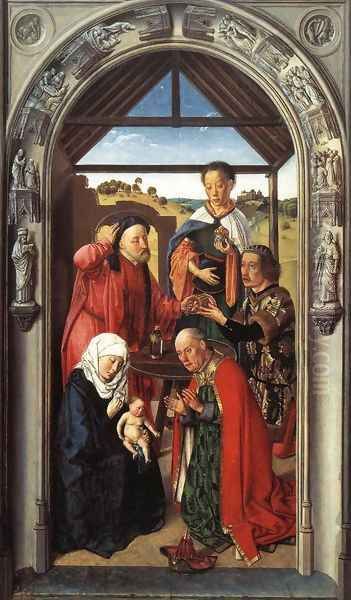
Dieric Bouts stands as a testament to the artistic vibrancy of the 15th-century Low Countries. From his beginnings in Haarlem to his celebrated career in Leuven, he navigated the rich artistic currents of his time, absorbing influences from giants like Van Eyck and Van der Weyden, yet emerging with a voice uniquely his own. His masterpieces, characterized by their meticulous detail, innovative spatial arrangements, and a profound, if understated, emotional resonance, continue to captivate. Whether depicting the solemnity of the Last Supper, the ordeal of a martyred saint, or the tender bond between Virgin and Child, Bouts infused his subjects with a quiet dignity and a palpable sense of the sacred. As a "creator of images," he not only reflected the devotional spirit of his age but also pushed the boundaries of painterly representation, leaving an indelible mark on the history of art.